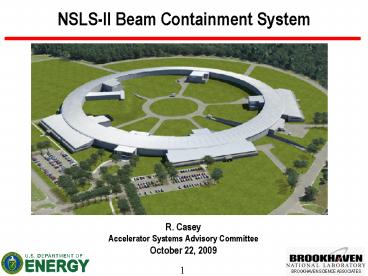NSLSII Beam Containment System PowerPoint PPT Presentation
1 / 15
Title: NSLSII Beam Containment System
1
NSLS-II Beam Containment System
R. Casey Accelerator Systems Advisory Committee
October 22, 2009
2
Beam Containment System
- Beam containment system (BCS) is the term used to
describe the various active and passive devices
designed to - Localize electron beam losses to selected (well
shielded) areas in the accelerator enclosures - Detect excessive beam loss outside of well
shielded areas - Provide linkage to other systems to mitigate
excessive losses when detected - Area radiation monitoring systems complement BCS
function by providing direct measurement of
radiation levels in occupied areas.
3
Beam Containment System (cont.)
- Objective - alert operators to excessive beam
losses that create potential for increased
radiation levels in occupied areas and provide
mitigation as required. - Mitigation measures include
- operator warnings and alarms
- direct curtailment of injection
4
Beam Loss Assumptions in Shielding Design
Injection region shielded for 3 GeV at 1 Hz
injection rate
Extraction region shielded for 3 GeV at 1 Hz
extraction rate
Injection region shielded for 200 MeV and I Hz
injection rate
5
Implications of Shielding Design
- Abnormal operating conditions need to be
evaluated. - Additional engineering or administrative controls
will be specified based on severity of radiation
levels under fault conditions. - An area radiation monitoring system is needed to
detect excessive radiation in occupied areas and
will serve as the primary safety system to
protect against radiation producing faults. - BCS is provided to detect abnormal conditions or
abnormal beam losses and provide warning to
machine operators. System will also inhibit
injection systems on alarm.
6
Actions Taken to Define BCS Systems
- The radiological consequences of abnormal
operating conditions have been described and
analyzed as part of on-going safety assessments - BCS task force appointed and work is underway to
finalize design - BCS functional requirements based on radiological
analyses have been presented - BCS components identified
7
BCS Task Force Setup to Define and Document BCS
- Task Force Members S. Kramer, Y. Li, I. Pinayev,
P.K. Job, D. Hseuh - Other stake-holders R. Casey, O. Singh, P.
Cameron, B. Delasio - Working Group has been meeting regularly since
Spring, 2009
8
Examples of Abnormal Events and Consequences
- Full beam loss in Linac at design beam current
(15 nA) - Max. dose rate 8 mRem/h
- Full beam loss in Booster injection region at 200
MeV - Max. dose rate 1 mRem/h with 1 Hz injection
- Full beam loss in Booster extraction region at 3
GeV - Max. dose rate 2.5 mRem/h with 1 Hz injection
9
Abnormal Events and Consequences (cont.)
- Full beam loss in remainder of booster at 3 GeV
- Max. dose rate 1500 mRem/h above berm, 375
mRem/h in injection building with 1 Hz injection - Full injected beam loss in Storage Ring (SR)
injection region - Max. dose rate 2.5 mRem/h with 1 Hz injection
- Full injected beam loss at one point in SR
non-injection region - Max. dose rate 400 mRem/h with 1 Hz injection
10
Current Definition of BCS Components
- Scrapers in SR injection region (4)
- R D at NSLS for thin scraper design planned for
FY 10 - Current Transformers (5)
- Linac (ICT)
- Linac to Booster transfer line (ICT)
- Booster (DCCT)
- Booster to SR transfer line (ICT)
- SR (DCCT)
- Beam loss monitors (Type and TBD)
- SR at potential high loss points (steering and
energy dispersive maxima) - R D at NSLS for Cerenkov BLM planned for FY 10
11
Area Radiation Monitors
- 2 - linac klystron gallery
- 6 - injection building
- 30 - Storage ring wall (1 per cell)
- 6 - FOE wall
- Budgeted for 60 monitors
12
BCS Functions
- Monitor and limit beam current in injection
system and SR - Detect high beam losses in injection or
extraction processes in booster by comparison of
current transformers (CTs) in transport line and
booster - Detect high beam losses in injection to SR by
comparison of CTs in transport line and SR - Provide scrapers and monitors in SR injection
region to localize and confirm losses in that
region (need for additional monitors in
non-injection areas being evaluated) - Alert machine operators to abnormal conditions
and inhibit continued injection as warranted
13
Interface between Systems for BCS
- Insure signals are available at rate needed,
insure integrity of communication link - Define the responsibility for calibration of
these signals and their maintenance - Issue Warnings if beam loss limit is being
approached, suggest operator action needed - Limit exceeded at present injection rate, issue
Alarm that action is required within prescribed
time. - If exceeded for significant time interval, remove
injection permit through BCS control network
Warnings Alarms to systems and operator
Linac transport CT signals
BCS Micro Booster injection OK Storage ring
injection OK Beam loss location OK Permit
Injection On/Off
Booster and transport CT signals
SR CT signals
Beam loss location monitors
BCS Controlled Device Interface Box Injection
On/Off
14
BCS Summary Look Ahead
- BCS task force is appointed and work is underway.
BCS function specified. - Specification of BCS components is almost
complete, more work required to specify location
and type of beam loss monitors and ddesign of
scrapers. - Warning and alarm set points for BCS will be
established through fault testing and radiation
measurements during commissioning. - BCS components will be subject to configuration
control during installation, testing, operation,
maintenance, and modification. - BCS interlocking functions are intended for
routine operation. During commissioning and
other times of machine studies, BCS interlocking
may be temporarily removed. Protective function
will be provided through work controls approved
for the time period of the study.
15
- Questions or Comments?

